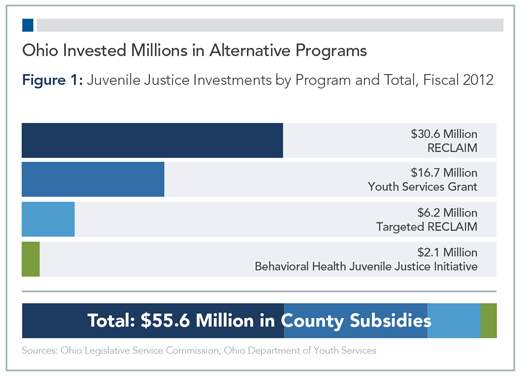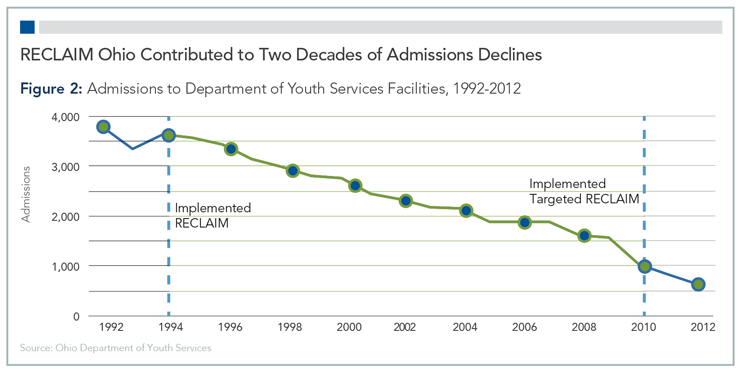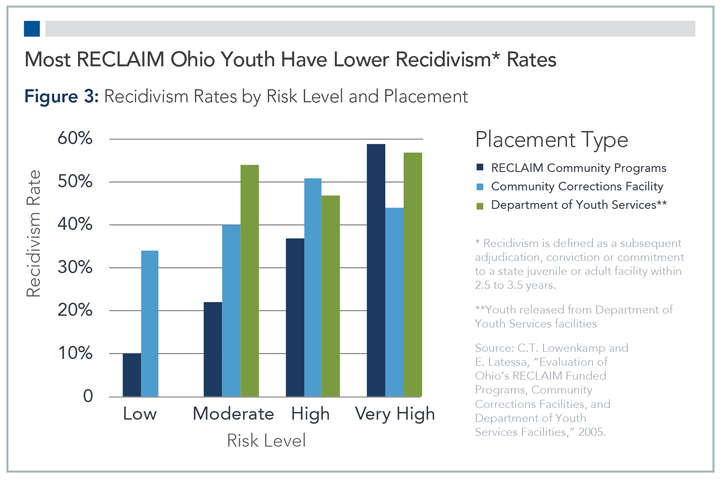State-Local Partnership in Ohio Cuts Juvenile Recidivism, Costs
Beginning in 1994, Ohio implemented RECLAIM Ohio, a performance-based funding partnership between the state and local governments that expanded counties' use of effective, cost-efficient, community-based options for lower-risk juvenile offenders. The program has helped cut recidivism rates and saved the state millions of dollars.
Problem
As in most states, the juvenile justice population in Ohio grew rapidly during the late 1980s and early 1990s. By 1992, Ohio Department of Youth Services facilities had reached 180 percent of capacity.1 The state had few community-based alternatives to these crowded and expensive facilities, leaving judges with limited disposition options for youth offenders, even for minor offenses.
Reforms
Through RECLAIM Ohio, or Reasoned and Equitable Community and Local Alternatives to the Incarceration of Minors, the state enacted a comprehensive package of reforms to expand disposition options that would improve public safety and hold juvenile offenders accountable while reducing costs. The RECLAIM program supports community-based alternatives for juveniles, including those who would otherwise be committed to Department of Youth Services, or DYS, facilities and prompted the adoption of a statewide offender risk-needs assessment system.
-
Authorizing legislation: House Bill 152 of 1993 created the RECLAIM program.2 After a successful trial in nine counties in 1994, RECLAIM was expanded statewide in 1995.
-
Incentive funding: RECLAIM funds are allocated to counties through a statutory formula based on each county's average number of felony youth adjudications with deductions for each day a juvenile spends in a correctional facility rather than a community-based program. Exceptions are made for youth placed in a facility for certain serious offenses.3
-
Program support: In fiscal 2012, county subsidies for juvenile justice programs included $30.6 million in RECLAIM funds and $16.7 million from the state's Youth Services Grant initiative, supporting more than 600 programs that served nearly 110,000 youth.4 Between 1994 and 2013, the state provided more than $500 million in RECLAIM funds to counties.5

-
Standardized tools: To better evaluate juveniles' risk of reoffending and to match them with programs most likely to prevent recidivism, the state, in 2009, adopted the Ohio Youth Assessment System, standardizing a process that had used 77 different instruments across 88 counties.6
-
Focused expansion: In fiscal 2010, the state launched a second phase of reform, Targeted RECLAIM, to boost efforts in six counties that accounted for most DYS admissions.7 Targeted RECLAIM was expanded to eight more counties in fiscal 2012.
-
Evidence-based programs: Targeted RECLAIM provides funds for evidence-based programming to divert juvenile offenders from DYS and prohibits the use of funds for programs shown to be ineffective.8 Targeted RECLAIM is coordinated with a statewide Behavioral Health and Juvenile Justice Initiative, which provides home- and community-based interventions for youth with serious behavioral health needs.
Impact
By funding more effective community-based alternatives for juvenile offenders, RECLAIM saved Ohio as much as $45 for each $1 invested while improving public safety.9
-
Commitments down: Annual admissions to DYS facilities fell more than 80 percent between fiscal 1992 and 2012, from more than 3,700 to 633.10
-
The rate at which judges committed felony offenders to DYS facilities dropped from 21 percent in 1992 to 12 percent in 2011.11
-
Targeted RECLAIM's behavioral health interventions contributed to a 54 percent reduction in DYS admissions in the initial six target counties between fiscal 2009 and fiscal 2011.12
-
In 2012, DYS admissions in the 14 total Targeted RECLAIM counties fell more than 27 percent by the end of the fiscal year.13
-

- Costs reduced: For each dollar spent on a RECLAIM program, Ohio saved between $11 and $45 in offender-processing and estimated, long-term victim costs,14 and more than $50 million in operating expenses through the closure of four DYS facilities between 2009 and 2011.15
-
Public safety improved: A 2005 University of Cincinnati evaluation and cost-benefit analysis found that RECLAIM improved public safety:
-
Only 20 percent of RECLAIM juveniles recidivated — that is, were subsequently adjudicated, convicted, or committed to a state juvenile or adult facility — within 2.5 to 3.5 years, compared with more than 50 percent of those released from DYS facilities.16
-
Low- and moderate-risk juveniles placed in DYS facilities were at least twice as likely to recidivate as those in a community-based RECLAIM program. Outcomes were better in RECLAIM programs than in facilities for all but the very highest-risk youth.17
-
Similar results were found in a recent evaluation of Targeted RECLAIM: Low-risk juveniles who were sent to state facilities were more than three times as likely to be recommitted or incarcerated within six to 18 months of release compared with youth of equivalent risk levels who were assigned to evidence-based community programs.18 Moderate- and high-risk juveniles sent to facilities were more than twice as likely to be recommitted or incarcerated as their RECLAIM counterparts.
-

ENDNOTES
1 E. Latessa and C.T. Lowenkamp (2009). Reclaiming Texas Youth: Applying the lessons from RECLAIM Ohio to Texas. Austin, TX: Texas Public Policy Foundation, http://www.texaspolicy.com/center/effective-justice/reports/reclaiming-texas-youth-applying-lessons-reclaim-ohio-texas.
2 See Ohio Admin. Code. Chapter 5139-67, http://codes.ohio.gov/oac/5139-67; Ohio Rev. Code Ann. §5139.41, 5139.43, and 5139.44, http://codes.ohio.gov/orc/5139.
3 For more information see Ohio Department of Youth Services website, http://www.dys.ohio.gov/dnn/Community/RECLAIMOhio/tabid/131/Default.aspx; B. Riley (2012). “Investing in Juvenile Justice Community Alternatives.” State Budgeting Matters (pp. 6-7). Columbus, OH: The Center for Community Solutions, http://www.communitysolutions.com/associations/13078/files/sbmV8N5InvestingInJuvJusticeAlternativesBRiley092412.pdf.
4 M. Wolniewicz (2011). LSC Greenbook: Analysis of enacted budget, Department of Youth Services. Madison, OH: Legislative Services Commission, http://www.lsc.state.oh.us/fiscal/greenbooks129/dys.pdf; Ohio Department of Youth Services (2012). Annual report, fiscal 2012. Columbus, OH, http://www.dys.ohio.gov/DNN/LinkClick.aspx?fileticket=lTTbv3%2FXF%2Fw=&tabid=102&mid=544.
5 Budget allocation figures provided by Ohio's Department of Youth Services. March 2013.
6 E. Latessa, B. Lovins, and K. Ostrowski (2009). The Ohio Assessment System: Final report. Cincinnati, OH: Center for Criminal Justice Research, University of Cincinnati. http://www.uc.edu/content/dam/uc/ccjr/docs/reports/project_reports/OYAS_final_report.pdf.
7 The six counties are Cuyahoga, Franklin, Hamilton, Lucas, Montgomery, and Summit.
8 See Ohio Admin. Code. Chapter 5139-67-04, http://codes.ohio.gov/oac/5139-67-04.
9 C.T. Lowenkamp and E. Latessa (2005). Evaluation of Ohio's RECLAIM funded programs, CCFs, and DYS facilities: Cost-benefit analysis, supplemental report. Cincinnati, OH: University of Cincinnati, http://www.uc.edu/content/dam/uc/ccjr/docs/reports/project_reports/Final_DYS_Cost_Benefit.pdf.
10 Admissions data provided by Ohio's Department of Youth Services. November 2012.
11 Statewide felony adjudication and commitment data provided by Ohio's Department of Youth Services. November 2012.
12 R. Gies (2012). Expanding the Community Continuum for Serving Youth: RECLAIM Ohio and Targeted RECLAIM. Presented at the JDAI Inter-Site Conference. Houston, TX, http://www.jdaihelpdesk.org/intersiteconf2012/State Initiatives to Reduce Juvenile Incarceration - Ohio (2012 Conference).pdf.
13 Ohio Department of Youth Services (2012). Annual report, fiscal year 2012.
14 Lowenkamp and Latessa. (2005). Evaluation of Ohio's RECLAIM funded programs, CCFs, and DYS facilities: Cost-benefit analysis, supplemental report.
15 Marion Juvenile Correctional Facility (2009); Freedom Center (2009); Mohican Juvenile Correctional Facility (2010); Ohio River Valley Juvenile Correctional Facility (2011); National Juvenile Justice Network (2011). Bringing Youth Home: A National Movement to Increase Public Safety, Rehabilitate Youth and Save Money, http://www.modelsforchange.net/publications/297.
16 C.T. Lowenkamp and E. Latessa (2005). Evaluation of Ohio's RECLAIM funded programs, community corrections facilities, and DYS facilities. Cincinnati, OH: University of Cincinnati, http://www.uc.edu/content/dam/uc/ccjr/docs/reports/project_reports/Final_DYS_RECLAIM_Report_2005.pdf.
17 Ibid.
18 R.M. Labrecque and M. Schweitzer (2013). Targeted RECLAIM: University of Cincinnati Outcome Study. Cincinnati, OH: University of Cincinnati, http://www.dys.ohio.gov/DNN/LinkClick.aspx?fileticket=1UZwRTzl8U0=&tabid=211.











